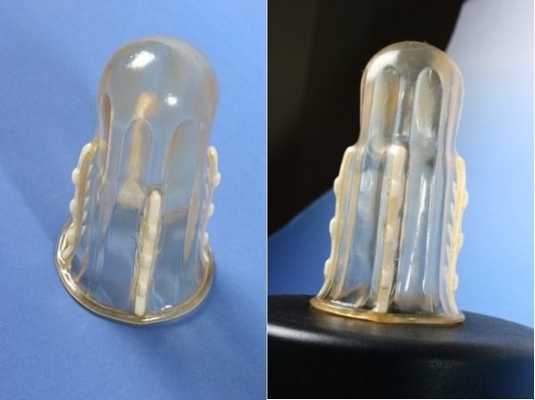 Miscellaneous
Miscellaneous  Miscellaneous
Miscellaneous  Animals
Animals 10 Strange Attempts to Smuggle Animals
 Travel
Travel 10 Natural Rock Formations That Will Make You Do a Double Take
 Movies and TV
Movies and TV 10 Actors Hidden in Your Favorite Movies
 Our World
Our World 10 Science Facts That Will Change How You Look at the World
 Pop Culture
Pop Culture 10 Incredible Female Comic Book Artists
 Crime
Crime 10 Terrifying Serial Killers from Centuries Ago
 Technology
Technology 10 Hilariously Over-Engineered Solutions to Simple Problems
 Miscellaneous
Miscellaneous 10 Ironic News Stories Straight out of an Alanis Morissette Song
 Politics
Politics 10 Lesser-Known Far-Right Groups of the 21st Century
 Miscellaneous
Miscellaneous 10 Undeniable Signs That People’s Views of Mushrooms Are Changing
 Animals
Animals 10 Strange Attempts to Smuggle Animals
 Travel
Travel 10 Natural Rock Formations That Will Make You Do a Double Take
Who's Behind Listverse?

Jamie Frater
Head Editor
Jamie founded Listverse due to an insatiable desire to share fascinating, obscure, and bizarre facts. He has been a guest speaker on numerous national radio and television stations and is a five time published author.
More About Us Movies and TV
Movies and TV 10 Actors Hidden in Your Favorite Movies
 Our World
Our World 10 Science Facts That Will Change How You Look at the World
 Pop Culture
Pop Culture 10 Incredible Female Comic Book Artists
 Crime
Crime 10 Terrifying Serial Killers from Centuries Ago
 Technology
Technology 10 Hilariously Over-Engineered Solutions to Simple Problems
 Miscellaneous
Miscellaneous 10 Ironic News Stories Straight out of an Alanis Morissette Song
 Politics
Politics 10 Lesser-Known Far-Right Groups of the 21st Century
10 More Recent Cases of Strange Behavior
Strange and bizarre news stories are fun to read. Every year hundreds of reports are made that document unusual experiments, inventions, criminal investigations, historical events and medical discoveries. Dozens of popular Internet websites are dedicated to publishing strange and bizarre news stories. This list will examine ten more recent cases of unusual behavior. It is the second article in a series that has examined this subject.

An anti-rape device is a product used for preventing, or deterring, rape. In the 15th century, chastity belts were designed for this purpose. In the last ten years, a collection of anti-rape devices have been marketed in areas of the world that have high rates of sexual abuse, such as South Africa. One such device is the rape-axe, or anti-rape female condom. The rape-axe was invented by a South African woman named Sonnet Ehlers. She was inspired to create the product after working with a patient who had experienced a traumatizing event. The woman said to Ehlers: “If only I had teeth down there,” referring to the myth of the vagina dentata (or toothed vagina).
The rape-axe is a latex sheath embedded with shafts of sharp, inward-facing barbs. It is designed to be worn by a woman in her vagina like a female condom. If an attacker was to attempt vaginal rape, his penis would enter the latex sheath and be snagged by the barbs, causing the person excruciating pain during withdrawal and hopefully giving the victim time to escape. The condom would remain attached to the man’s body and could only be removed by a doctor, which would alert hospital staff and police. Once the device is utilized, the perpetrator would not be able to walk or urinate.
The device was revealed to the public in 2005, but did not get distributed until 2010, when 30,000 of the condoms were passed out before the World Cup in South Africa. Some critics of the product have objected to Ehlers’ invention, calling it “vengeful, horrible, and disgusting” and are opposed to its sale in drugstores. Other critics fear that the device could possibly enrage an attacker and further jeopardize the victim. Ehlers asserts that she created the product in gradual steps. “I consulted engineers, gynecologists and psychologists to help in the design and make sure it was safe.” Ehlers has also pointed out that some women in South Africa take extreme measures to prevent rape, such as placing razor blades in their nether regions.

Given the age of the universe and the vast number of stars, unless the Earth is very atypical, extraterrestrial life should be common. The contradiction between the probability for the existence of alien civilizations, and the lack of evidence for them, has been labeled the Fermi paradox. On August 18, 2011, The Guardian published an article titled “Aliens May Destroy Humanity to Protect Other Civilizations, Say Scientists.” The article examines the idea that reducing greenhouse gases on Earth is necessary in order to reduce the probability that an alien civilization will attack humanity. It explains that extraterrestrials may view recent changes in the Earth’s atmosphere as a threat and a civilization growing out of control.
The highly speculative scenario is one of many described by a NASA-affiliated scientist and colleagues at Pennsylvania State University. It is claimed that humans need to take action in order to reduce the possibility of aliens becoming hostile in the future. Shawn Domagal-Goldman of NASA’s Planetary Science Division put together a report titled, “Would Contact with Extraterrestrials Benefit or Harm Humanity?” In the publication, researchers divide alien contacts into three broad categories: beneficial, neutral or harmful.
The report cautions humans in sending signals into space, and in particular warns against broadcasting information about our biological make-up, which could be used to manufacture weapons that target humans. It suggests that any contact made with an alien species should be done with the language of mathematics, until their intentions are made clear. The authors warn that aliens may be wary of civilizations that expand rapidly because it may threaten their existence. Other extraterrestrials might object to the damage humans have inflicted on the Earth’s environment. In the most extreme scenario, aliens might choose to destroy humanity. The report argues that considering these possibilities may help achieve long-term survival.

The Siberian tundra holds a collection of untold mysteries, including secret military installations and reported UFO sightings. The tundra is also a hotspot for alleged Yeti activity. In 1953, interest in the Yeti expanded when famed mountain climber Sir Edmund Hillary claimed to have found large human-like footprints on his ascent of Mount Everest. In October of 2011, a team of Russian scientists released a public statement indicating that they were “95%” sure that Siberia is home to the mythical Yeti or abominable snowman. In response to the news, more than a dozen scientists and Bigfoot enthusiasts traveled from Canada, Estonia, Sweden, and the U.S. to exchange their findings with the Russian group.
The scientists conducted a day-long conference in the town of Tashtagol, approximately 2,000 miles east of Moscow in the Kemerovo region. The area has a long history of Yeti encounters and the locals have reported an increase in sightings of late. The Russian researchers gathered evidence after conducting a two-day expedition in the region’s Azassky cave and Karatag peak. The group detected tracks, hairs, sleeping quarters, and various other markers for the Yeti. After the information was presented at the conference, participants agreed that the artifacts provided strong evidence for the existence of a large creature in the Kemerovo region. It has long been thought that Siberia is a good habitat for Yeti. The story was reported by various media outlets, but unfortunately without pictures, video, a body, or strict DNA evidence, the mystery of the Yeti will remain unproven.

In 2011, Canadian doctors at Queen’s University were shocked when they discovered a bizarre ultrasound that shows the testicle of a man that was complaining of severe pain. After examination of the image, it became clear that a human face can be identified near the man’s testicle. You can see a large mouth, noise, and two eyes in the image. The face seems to be in distress. Dr. Naji Touma, a professor at Queen’s University Medical School was quoted as saying “The image was very ghoulish, like a man screaming in pain. His mouth was open and it looked like one eye was gouged out.”
The ultrasound shocked medical professionals, and a brief debate ensued about whether the image could be a sign from a deity (perhaps Min, the Egyptian God of male virility). However, the consensus ruled that the shape was a mere coincidental occurrence rather than a divine proclamation. The case has been identified as an example of pareidolia, which is a psychological phenomenon that occurs when people perceive a vague and random stimulus (often a face) as being significant. The ultrasound was sent to the journal Urology, and in 2011 an article was published under the tongue-in-cheek headline: “The face of testicular pain: A surprising ultrasound finding.” As for the patient, the 2-inch (5.1 cm) growth was diagnosed as a benign tumor, the result of an infection, and the testicle was removed.

In 2006, an American man living in Edinburgh named Tom MacMaster decided to create a fictional Internet character named Amina Abdallah Arraf al Omari. The identity of Amina was presented as a Syrian-American blogger. She was made to be a lesbian, and in 2011 MacMaster started a popular blog named A Gay Girl in Damascus under the name. In his postings, MacMaster preached in support of increased civil and political rights in Syria. He said that he created the Amina character in order to participate in discussions about the Middle East. MacMaster believed that if he used his real name, people would have presumed him too closely tied to the United States.
Tom MacMaster developed an extensive background for the character and began writing a novel based on her fake life. He created various profiles for Amina on social networking websites, and began to participate in conversations about Middle East politics. On February 19, 2011, after the Syrian uprising started, MacMaster created the A Gay Girl in Damascus blog. The publication was known for its witty commentary on politics, gender, sexuality and Syrian culture. In the words of Nidaa Hassan of The Guardian, “the site was increasingly popular after capturing the imagination of the Syrian opposition as the protest movement struggled in the face of the government crackdown.”
On June 6, 2011, MacMaster’s blog posted a statement from “Amina’s” cousin which claimed that she was abducted. The information sparked a strong backlash over the Internet and the story was covered widely in the mainstream media. In the wake of the reports, questions began to come up regarding the possibility that Arraf al Omari was an elaborate hoax. It was soon proven that the photos of Amina were really of a woman residing in Britain who had no relation to Syria. On June 12, 2011, Tom MacMaster posted a statement on the blog that indicated the character was an elaborate hoax. The event showed how easy it is for an individual to create a false identity on the Internet and impact political movements around the world.

In 1920, John Demjanjuk was born, in Dubovi Makharyntsi, Ukraine. When he was 21-years-old, Demjanjuk joined the Red Army after Germany invaded the Soviet Union. In the middle of World War II, Demjanjuk became a German prisoner of war and was enrolled in a Nazi propaganda program. He was sent to the Trawniki concentration camp, where he trained guards that had been recruited from Soviet POWs. Demjanjuk became a high ranking German guard and served in the Majdanek, Sobibor, and Flossenbürg Nazi extermination camps. In 1952, Demjanjuk, his wife and their child immigrated to the United States. On November 14, 1958, Demjanjuk became a naturalized citizen of the U.S.
In August 1977, the U.S. Justice Department submitted a request to have John Demjanjuk’s citizenship revoked, based on the fact that he had allegedly concealed involvement with Nazi death camps on his immigration application. An investigation ensued and Demjanjuk was identified in a photo spread by five Holocaust survivors as a Nazi guard. In October 1983, Israel issued an extradition request for Demjanjuk. After a lengthy appeal, he was deported to Israel on February 28, 1986. Demjanjuk was put on trial before a special tribunal. The principal allegation was that three former prisoners identified him as Ivan Grozny of Treblinka, which is Russian for “Ivan the Terrible,” who is said to have operated the diesel engines sending gas to the death chamber.
On April 18, 1988, the court found Demjanjuk guilty of all charges. One week later he was sentenced to death by hanging. On July 29, 1993, five Israeli Supreme Court judges overturned the guilty verdict. The ruling was based on the written statements of 37 former guards at Treblinka that identified Ivan the Terrible as Ivan Marchenko. The Israeli Supreme Court ruled that the KGB had possibly formed a plot to frame Demjanjuk as Ivan the Terrible, in order to get retribution for his betrayal. In 1993, Demjanjuk was released and returned to the United States. On May 19, 1999, the U.S. Justice Department filed a new civil complaint against Demjanjuk.
The complaint alleged that Demjanjuk served as a guard at the Sobibór and Majdanek extermination camps in Poland under German occupation. On December 28, 2005, a U.S. immigration judge ordered Demjanjuk deported to Germany, Poland or Ukraine. He filed a collection of appeals based on the fact that, if deported to Ukraine, he feared torture. On June 19, 2008, Germany announced that it was going to seek the extradition of John Demjanjuk to Germany. They released a statement: “For the first time we have found lists of names of the people who Demjanjuk personally led into the gas chambers. We have no doubt that he is responsible for the death of over 29,000 Jews at the Nazis’ Sobibor death camp.” On May 12, 2011, John Demjanjuk was convicted as an accessory to the murder of 27,900 Jews and sentenced to five years in prison. He was released pending appeal and is now living in a German nursing home.

Michelangelo was an Italian Renaissance painter, sculptor, architect, poet and engineer who had a great influence on the development of Western art. During his lifetime Michelangelo completed dozens of sculptures that examine the life of Jesus, Mary, and themes of Christianity. Approximately 40 of his sculptures still exist in museums around the world. However, the paintings of Michelangelo are less common, with only 8 remaining examples. As with any great artist, international collectors are always on the lookout for lost and misplaced paintings. Since 2010, there have been two separate cases where a Michelangelo painting may have been discovered.
The first involves a family from Buffalo, New York, who claim they have a lost Michelangelo painting. In 2003, U.S. Air Force Lt. Col. Martin Kober contacted museum directors in Italy to try and authenticate a painting that was passed down in his family. The information caught the attention of art restorer and historian Antonio Forcellino, who became convinced that the painting was a genuine Michelangelo. The painting is named “Pieta bread” and shows a portrait of Jesus’ body at the feet of Mary. The theme of the work is similar to the famous Michelangelo sculpture titled Pieta, which shows the body of Jesus on the lap of his mother. It has been determined that Michelangelo painted the image in 1545 for his friend Vittoria Colonna.
A scientific analysis of the painting, including an infrared and X-ray examination showed that the artist made a series of alterations to this copy of Pieta bread. The bottom right portion of the woman’s leg is missing and the artwork is incomplete. The evidence demonstrates that the painting could not be a copy. If authenticated, Pieta bread has been valued at $300 million. In 2011, another possible Michelangelo painting surfaced in Campion Hall, at Oxford University. The artwork is titled “Crucifixion with the Madonna, St John and Two Mourning Angels.” The painting was previously believed to have been done by Marcello Venusti, a Mannerist painter who sometimes worked from Michelangelo’s designs.
In 2011, art historian Antonio Forcellino (the same man involved with the previous case) became convinced that the Oxford painting was an authentic Michelangelo. Forcellino scientifically examined the art using infrared photography and found that the painting was based on a cartoon that Michelangelo created. Forcellino was able to associate the painting with a close friend of the famous artist, Tommaso Cavalieri, by the presence of 18 seals of the Cavalieri family coat of arms still present on the edge of the panel. The Oxford artwork is owned by the British Province of the Society of Jesus, who plans to take advantage of the news and sell it at auction. The painting has been estimated to fetch at least $100 million.

Since 1972, there has been a dramatic reduction in the number of feral honey bees in the United States, which are now almost extinct. It has become clear that an unknown factor is threatening the existence of bees around the world. The phenomenon has become known as colony collapse disorder. By February 2007, large commercial migratory beekeepers in several U.S. states had reported heavy losses associated with CCD. Colony losses were also reported in five Canadian provinces, several European countries, and in South America, Central America and Asia. The mechanisms of CCD are unknown, but many causative agents have been proposed, including malnutrition, pathogens, immunodeficiencies, mites, fungus, pesticides, and electromagnetic radiation (EMR).
In October 2011, a review study was published by the Indian government’s Ministry of Environment and Forests that looked at 919 peer-reviewed scientific studies that investigated the impact of electromotive force (EMF) on birds, bees, humans, animals/wildlife and plants. Six articles on bees claimed to find evidence for negative side effects related to the exposure of EMF radiation. One experiment noted that when a mobile phone was kept in a beehive, worker bees stopped coming to the hive after ten days. The same study found a drastic decrease in the egg production of queen bees when a mobile phone was present. The authors concluded that “Existing literature shows that EMRs are interfering with the biological systems in more ways than one.” They recommended recognizing EMF as a pollutant.
In early October 2011, millions of honey bees died in the area of Brevard County, Florida. The case has baffled experts because the bees appear to have been poisoned. The bodies do not resemble any recorded examples of colony collapse disorder. It cannot be determined exactly what killed the colonies, but as many as 12 million bees from 800 hives in Brevard County, on central Florida’s Atlantic coast died during a seven day span. The bee carcasses show signs of pesticide poising and the case is being investigated as a possible crime. In an interesting coincidence, county officials sprayed mosquito-killing pesticide from the air in the week prior to the deaths. They said the poison dissipates quickly and should not have harmed the bees. The colonies are being tested to determine the exact cause of death, but no official information has been released.

Muskingum County Animal Farm was a private zoo located in Zanesville, Ohio, United States, that was owned and operated by a man named Terry Thompson. On October 19, 2011, Thompson freed dozens of his exotic animals and then committed suicide. His property housed approximately 60 dangerous animals, including a large collection of Bengal tigers, bears, lions, wolves, monkeys, baboons, and mountain lions. After assessing the immediate danger of the situation, local officers decided to kill the animals instead of trying to bring them down with tranquilizers, for fear that those hit would escape into the darkness.
In the hours following the escape, 49 of the 56 animals were killed, including 18 Bengal tigers, 9 male lions, 8 female lions, 6 black bears, 3 mountain lions, 3 grizzly bears, 2 wolves, and a baboon. Six animals were captured alive and taken to the Columbus Zoo and Aquarium, including a grizzly bear, three leopards and two monkeys. The last animal missing was a monkey that is thought to have been eaten by one of the big cats. As the hunt was completed, a photo showing the remains of tigers, bears and lions scattered in an open field went viral and inspired strong reactions of anger and sadness on the Internet.
In the aftermath of the event, The Humane Society of the United States criticized the Governor of Ohio, John Kasich, for allowing a statewide ban on the buying and selling of exotic pets to expire in April of 2011. Terry Thompson, 62, had previously received numerous complaints about animals escaping onto his neighbors’ property. The sheriff’s office said that Thompson had been charged with animal cruelty, animal neglect and allowing animals to roam. In June of 2008, The Bureau of Alcohol, Tobacco, Firearms and Explosives raided Thompson’s property and seized more than 100 guns. The tragic event has sparked concern over laws that manage exotic animal ownership in the United States.

The Phantom of Heilbronn, or the woman without a face, is a hypothesized unknown female serial killer whose existence was inferred from DNA evidence found at numerous crime scenes in Austria, France and Germany, from 1993 to 2009. The DNA sequence of the woman was discovered at over 40 separate crime scenes, including six murders and several burglaries. In 2009, German authorities became baffled by the occurrence and put out a $400,000 reward on the woman’s head. Profilers from around Europe came to help the investigation and a collection of newspapers declared it “the most mysterious serial crime of the past century.”
As the DNA of the woman continued to appear, contradictions emerged. The accomplices of the phantom showed no identifiable patterns, and the criminals territory stretched throughout Germany and into Austria and France. The woman had never been captured on camera or been described by a witness. In 2009, for reasons unknown, police became interested in the corpse of a burned man that was discovered in 2002. While trying to establish the identity of the body, investigators pulled the phantom’s DNA from the man’s fingerprints. The event was an anomaly as the sequence of the phantom’s DNA was that of a female and the victim was a male. The event caused researchers to repeat the test with a different cotton swab and this time they found no trace of the phantom’s DNA. In Austria, the phantom’s DNA sequence showed up on the test of an unidentified male donor.
The two cases raised suspicion that the DNA found at all the crime scenes might be traced to a single factory worker, probably employed to package the swabs. According to reports, the tainted material was traced to the Austrian company Greiner Bio-One International AG. The Austrian manufacturer hurried to declare that the Greiner Bio-One cotton swabs are not certified for DNA analysis and should not have been used for that purpose. In late March 2009, investigators concluded that the Phantom of Heilbronn did not exist, and the DNA recovered at the crime scenes had already been present on the cotton swabs used for collecting DNA samples.
It was a shocking realization, and Stefan König of the Berlin Association of Lawyers said the case of the phantom illustrates the risks of basing an investigation solely on DNA evidence. The explanation has spawned a large collection of conspiracy theories, as the mathematical probability of only one worker being identified as the tainted donor for the swabs is bizarre. The governments of Germany, Austria and France admitted that they extensively used tainted DNA swabs from 1993-2009. Based on the detailed timeline, you would think that the worker responsible for the contamination would have been tracked down, but the individual has never been discovered. The case remains open and officials continue to monitor DNA swabs.








